Keystone Values for Building the Jewish Future

בַּסֻּכֹּת תֵּשְׁבוּ שִׁבְעַת יָמִים
כָּל־הָאֶזְרָח בְּיִשְׂרָאֵל יֵשְׁבוּ בַּסֻּכֹּת.“For seven days, you will dwell in booths:
All the citizens of Israel will dwell in booths.”
Master Builders who preceded us refined principles for building the Jewish future in their own days and ways. Bayit’s keystone values evolve from theirs, much as their values evolved from their teachers, up through Jewish history’s centuries of architects, builders and decorators.
Here are some values by which we aim to align all that we’ll build together. Fittingly for builders, we anchor these keystone values in Torah’s call to build booths and dwell in them for the Jewish festival of Sukkot.
- We’re All Builders and Dwellers: Democratize Experience
“All … will dwell in booths” (Lev. 23:42). The upshot is clear: an authentic Jewish future worth building must be for “all.”
“All” invites everybody and excludes nobody. “All” refuses qualifiers and disqualifiers. “All” is radically inclusive: whoever you are, you’re welcome.
“All” shouldn’t be a radical idea. If inclusivity seems radical, it’s because inclusivity hasn’t always been so, well, inclusive. Consider what you believe Jewish life most asks to be built. Whatever your ideas about who isn’t part of it, or can’t or won’t be part of it, those ideas point to what’s most important to build. The Jewish call is to include the excluded.
“All” also means that we’re “all” builders, not just dwellers. A desert-wandering tribe (then), and a globally dispersed Jewry (now), are too large and diverse for any centralized team of sukkah builders to do the building for everyone. Thus, the only way for “all” to heed this call to dwell is for “all” to pitch in and build – and to expand the very idea of building to include “all.”
It’s not only “do it yourself” (DIY) Judaism, but that there’s no other Judaism except DIY. The Jewish call is the call to do. “All” are called to “make” Shabbat (Ex. 31:16); same for tzitzit (Num. 15:38); same for a sukkah. To Rabbi David Ingber, “We need a Judaism with calluses on its hands and dirt under its fingers.” Essentially, we need a Judaism with builders’ hands.
That’s our first principle: we’re all builders. In Talmud’s words, “and all Your children will be … builders” (B.T. Berakhot 64a). Everything we do must inspire and support the universal call to build, the experience that is the foundation of Jewish life.
- Backwards Compatibility: Build for Purpose
Structures have functions. Lose touch with functions, and structures won’t serve well.
Torah points to not only what to build but also why to build. A sukkah reminds of the Exodus from bondage and the joy of liberation (Lev. 23:43). Shabbat reminds of creation’s miracle and the Creator’s call to soul (Ex. 31:17). Tzitzit are to be seen as a reminder of holy connection so we don’t get lured away by routine or base distraction (Num. 15:39-40).
Maimonides called it purposive inquiry: the call to build has reasons we can discern and fulfill by keeping them at the core of what and how we build. Rabbi Irwin Kula put it in economic terms: if building were a employee, why would we hire it? Reb Zalman Schachter-Shalomi put it in technological terms: today’s building must be backward compatible with the past sufficient to maintain interoperability and channelize change, while serving needs of today and tomorrow.
That’s our second principle: we build for purpose. We will privilege “why” over “what”; we will prioritize experience over stricture. Whatever building ideas may arise from tradition, aesthetics, comfort, convenience or feel-good self-validation, we will gauge them against the primacy of the democratic call to build and the foundational purposes of each structure. We’ll design and build with those purposes as our purposes. We’ll keep returning to this purposive inquiry and ask if the building serves the intended purposes – not the other way around.
- Balancing Design Expertise and User Experience: Assess From the User
Judaism’s textual complexity, plus modernity’s threads of doctrinal liberalism and self-empowerment, together fuel a disjoint in Jewish life that builders can and must address. Many moderns have come to feel that they don’t know enough to be builders, so they defer to “experts” or drop out. For their part, “experts” lament what they call the decline of Jewish fluency: they worry that a Jewish life geared to what’s popular will trivialize Jewish life in a race to the bottom. The retort, from thinkers like Rabbi Dan Libenson, is that “expert” Judaism is exactly the problem: an “expertise” orientation is tantamount to arrogance that naturally tends to propagate itself at the expense of innovation and the public.
Our view seeks a nuanced modern “build” on tradition’s platform. We embrace the marketplace of ideas: people vote with their feet, time and money – and this is good. Time and again, Talmud gives binding authority to what a silent majority does: no ruling is valid if the public won’t live it, and behavioral standards map to public norms. And for those concerned that the public doesn’t know enough, Hadar’s Rabbi Ethan Tucker reminds that we are to regard even most seemingly “empty” of knowledge as if they’re full of mitzvot (B.T. Eruvin 19a).
This means gauging the effectiveness of building not from builders’ perspectives but from user perspectives (i.e. the public). It means not diminishing or couching public responses for lack of expertise but, quite the contrary, assuming public responses to be correct.
It takes savvy to make this leap of faith, especially when builders feel vested in what they build. It asks strength to build structures in ways that avert “insider” tendencies to feel superior based on expertise, experience or sweat equity. It takes great effort to break naturally insulating circles of influence that encourage groupthink. But that’s what we must do to build for purpose.
- Inclusion and Continuity: Yes, Try Rotating Leadership
Stories abound about how Reb Zalman understood leadership to be fluid, not fixed in any one person or role. So important was this fluidity – and the ability to step gracefully into and out of leadership roles – that Reb Zalman famously taught about having circles of people stand up and move one seat to the left so that each could feel oneself to be in the “rebbe seat.”
Leadership is important to any effective system for many reasons – coordinating efforts, holding the whole, articulating and modeling values, enforcing rules and structure, mediating and channelizing conflict, and more. Often ideas fail not because ideas aren’t good but for lack of effective leadership.
We at Bayit believe so strongly in what Reb Zalman taught that we’re pioneering a governance model based on it. Every three months, we rotate leadership in alphabetical order by last name. We do so intending to inculcate buy-in and diversity of influence by gender, age, background and experience. We also seek to cultivate inner characteristics of empowerment and humility necessary for effective building.
Building also needs practical leadership too easily lost to pure rotation. For continuity and readiness, our current leader works with the vice chair (next in order) and past chair (most recent in order). Other governance tools uplift responsibility, load sharing and accountability.
Like all we do, we’ll report back on how this leadership experiment works, what we learn from it, what we’ll propose changing, and how you can try it.
- Living in the Earthquake Zone: Design for Crash-Flex Building
Take this in: everything in Jewish life (and, human life) lives in a zone of seismic activity. Both literally (tectonic plates) and figuratively (social change), we all live on shifting ground. There are important implications for what we build and how we build.
Rabbi Benay Lappe taught in her now-famous “Crash Talk” (TED 2014) about the inevitability of change, often starting with the inside out. Our core “master story” ideas about who we are – often built on things that themselves change – suddenly will break down against experience, received tradition or norms that no longer feel like they “fit.” When this inevitable “crash” of our “master story” happens, we have three choices: we can pretend away the “crash” (causing internal harm), drop out (often easier but ultimately unappealing) or re-engage and change the “master story.”
Reb Zalman used slightly different language for a similar idea. Some times are smoothly continuous but others are real paradigm shifts – when rapid social, economic, environmental and/or political change so sharply alter reality that continuity is neither feasible nor justified. In those moments, foundations jolt and we must reinvent because the foundation of what was no longer is. Often reinvention can redeploy what came before in new ways – an important form of backward compatibility – but not as it was before the shift.
Put simply, we all live in the seismic zone. We all live amidst a cycle of “crash” in an era of paradigm shift. We can pretend otherwise and be swept away, or we can build for it.
What does it mean to build in this way? To us, it means taking a page from architectural seismic codes: “Earthquakes don’t kill people – buildings do.” If we build wrong, people (hearts, minds, souls, communities) suffer less from the inevitability of change and more from the flawed premise that we can build to out-maneuver change.
Rather, we aspire to build in ways that are “crash-flex.” “Crash-flex” building designs more for adaptability than stable permanence. It means affirming and encouraging diversity and adaptation, not centralized fixed design. The more individuals and groups engaged in building, the more structures will align with ever-shifting foundations of self (“master story”) and ground conditions (economic, social and political realities). It means disciplined focus on building tools and clear outside assessment. It means being less afraid to fail than to build so rigidly that change can topple structures on people’s heads.
- Castles Don’t Belong in the Sky: Build on the Ground
 Principles tend to be abstract: they need to be proved by living them. Builders live for bringing abstraction down to the ground. That’s what we aim to do.
Principles tend to be abstract: they need to be proved by living them. Builders live for bringing abstraction down to the ground. That’s what we aim to do.
We can philosophize from today until forever, but we don’t live in philosophy. Without actual design systems, products, tools, distribution systems, governance system and the like, all we’ll “build” is castles in the sky that might look pretty but nobody can live in them. The Judaism most worth building is a Judaism that’s lived here and now.
That’s one reason the Hebrew letter bet (ב) is our symbol. Bayit is Hebrew’s word for house, an actual structure, and the letter bet (ב) stands firmly on the ground, like a sukkah we can actually dwell in – not a castle in the sky, but a structure for actual, flexible living.
What values inspire your own call to build?

Rabbi David Markus

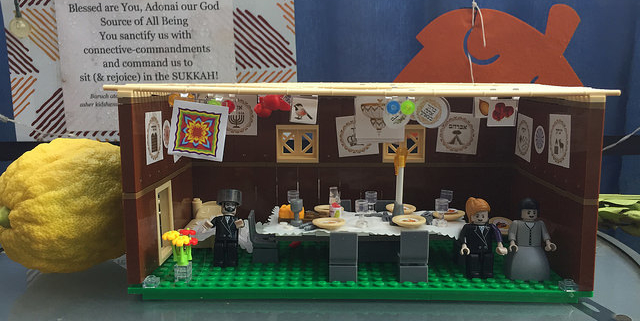
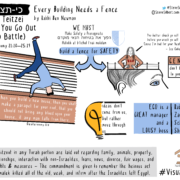
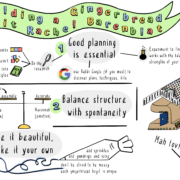

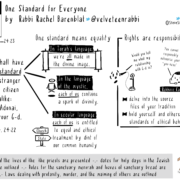
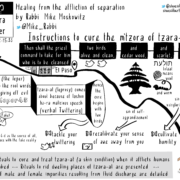
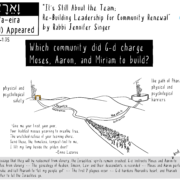


Thanks for all the information.